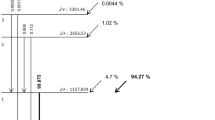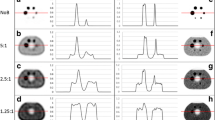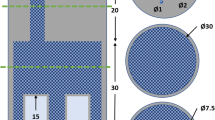Abstract
Several yttrium-90 labelled somatostatin analogues are now available for cancer radiotherapy. After injection, a large amount of the compound is excreted via the urinary tract, while a variable part is trapped in the tumour(s), allowing the curative effect. Unfortunately, the compound may also be trapped in critical tissues such as kidney or bone marrow. As a consequence, a method for assessment of individual biodistribution and pharmacokinetics is required to predict the maximum dose that can be safely injected into patients. However, 90Y, a pure β–particle emitter, cannot be used for quantitative imaging. Yttrium-86 is a positron emitter that allows imaging of tissue uptake using a PET camera. In addition to the positron, 86Y also emits a multitude of prompt single γ-rays, leading to significant overestimation of uptake when using classical reconstruction methods. We propose a patient-dependent correction method based on sinogram tail fitting using an 86Y point spread function library. When applied to abdominal phantom acquisition data, the proposed correction method significantly improved the accuracy of the quantification: the initial overestimation of background activity by 117% was reduced to 9%, while the initial error in respect of kidney uptake by 84% was reduced to 5%. In patient studies, the mean discrepancy between PET total body activity and the activity expected from urinary collections was reduced from 92% to 7%, showing the benefit of the proposed correction method.






Similar content being viewed by others
References
Forster GJ, Engelbach M, Brockmann J, Reber H, Buchholz HG, Macke HR, Rösch F, Herzog H, Bartenstein P. Preliminary data on biodistribution and dosimetry for therapy planning of somatostatin receptor positive tumours: comparison of Y-86-DOTATOC and In-111-DTPA-octreotide. Eur J Nucl Med 2001; 28:1743–1750.
Rösch F, Stolz B, Brockmann J, Köhle M, Muhlensiepen H, Marbach P, Herzog H, Muller-Gartner HW. Uptake kinetics of the somatostatin receptor ligand [86Y]DOTA- d -Phe1-Tyr3-octreotide (86Y-SMT487) using positron emission tomography in non-human primates and calculation of radiation doses of the 90Y-labelled analogue. Eur J Nucl Med 1999; 26:358–366.
De Jong M, Valkema R, Jamar F, Kvols LK, Kwekkeboom DJ, Breeman WA, Bakker WH, Smith C, Pauwels S, Krenning EP. Somatostatin receptor-targeted radionuclide therapy of tumors: preclinical and clinical findings. Semin Nucl Med 2002; 32:133–140.
Herzog H, Stöcklin G, Lueders C, Qaim SM, Rösch F, Feinendegen LE. Measurement of pharmacokinetics of yttrium-86 radiopharmaceuticals with PET and radiation dose calculation of analogous yttrium-90 radiotherapeutics. J Nucl Med 1993; 34:2222–2226.
Rösch F, Plag C, Neumaier B, Braun U, Müller-Gärtner HW, Herzog H, Stöcklin G. Radiation dose of yttrium-90 citrate and yttrium-90 EDTMP as determined via analogous yttrium-86 complexes and positron emission tomography. Eur J Nucl Med 1996; 23:958-966.
Wester HJ, Rösch F, Herzog H, Smith-Jones P, Stolz B, Bruns C, Brockmann J, Stöcklin G. PET-pharmacokinetics off 18F-octreotide: a comparison with 67Ga-DFO- and 86Y-DTPA-octreotide. Nucl Med Biol 1997; 24:275–286.
Erdtmann G, Soyka W. Die γ-Linien der Radionuklide Band 1. KFA Julich September 1973.
King MM. Nuclear data sheet 1997; 80:567.
Firestone RB, Baglin CM, Chu FS, Shirley VS, Zipkin J. In: Shirley V, ed. Table of isotopes.New York: Wiley-Interscience; 1996:510–512.
Pagani M, Stone-Elander S, Larsson SA. Alternative positron emission tomography with non-conventional positron emitters: effects of their physical properties on image quality and potential clinical applications. Eur J Nucl Med 1997; 24:1301–1327.
Martin CC, Satter MR, Nickerson LDH, Christian BT, Nickles RJ. Quantitative PET with positron emitters that emit prompt gamma rays. IEEE Trans Med Imag 1995; 14:681–687.
Pentlow KS, Larson SM, Erdi YE, Finn RD, Humm JL. Phantom measurements to investigate the use of yttrium-86 and PET to determine the in vivo distribution of yttrium-90 labelled pharmaceuticals. J Nucl Med 1998; 39:791–791.
Pentlow KS, Larson SM, Erdi YE, Finn RD, Humm JL. Effects of cascade gamma rays in PET imaging quantitation. J Nucl Med 1999; 40:1238–1238.
Kohlmyer SG, Shoner SC, Lewellen TK, Miyaoka RS, Eary JF. Quantitative accuracy of PET imaging with yttrium-86. J Nucl Med 1999; 40:1237.
Hudson HM, Larkin RS. Accelerated image reconstruction using ordered subsets of projection data. IEEE Trans Med Imaging 1994; 13:601–609.
Shepp LA, Vardi Y. Maximum likelihood reconstruction for emission tomography. IEEE Trans Med Imaging 1982; 2:113–122.
Lange K, Carson R. EM reconstruction algorithms for emission and transmission tomography. J Comput Assist Tomogr 1984; 8:306–316.
Wienhard K, Eriksson L, Michel C, Bruckbauer T, Pietrzyk, Dahlbom M, Heiss WD. The ECAT EXACT HR: performance of a new high resolution positron scanner. J Comput Assist Tomogr 1994; 18:110–118.
Rösch F, Qaim SM, Stöcklin G. Production of the positron emitting radioisotope 86Y for nuclear medical applications. Int J Appl Radiat Isot 1993; 44:677–681.
Author information
Authors and Affiliations
Corresponding author
Rights and permissions
About this article
Cite this article
Walrand, S., Jamar, F., Mathieu, I. et al. Quantitation in PET using isotopes emitting prompt single gammas: application to yttrium-86. Eur J Nucl Med 30, 354–361 (2003). https://doi.org/10.1007/s00259-002-1068-y
Received:
Accepted:
Published:
Issue Date:
DOI: https://doi.org/10.1007/s00259-002-1068-y




